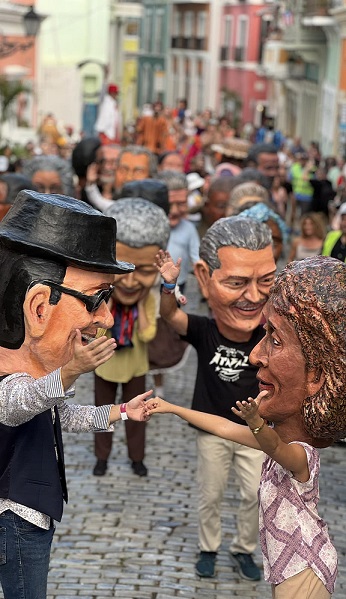
The 54th edition of the San Sebastián Street Festival [Fiestas de la Calle San Sebastián] is under way. The celebration—which brings together every type of cultural manifestation under the sun—began on Thursday, January 18 and will continue through Sunday, January 21. El Nuevo Día calls the event the largest cultural celebration of the Caribbean, a celebration that brings together about half million people in Old San Juan every year. Here, Rut N. Tellado Domenech highlights the cultural and historical origins of this festivity, explaining that “knowing the origin of the San Sebastián Street Festival provides a valuable cultural context, strengthens identity, enriches experiences, and fosters understanding among citizens.” Here are excerpts from the article. [Also see previous post Agua, Sol y Sereno at SANSE. Photo above by Julio Ramos.]
The cabezudos [literally, “big heads”; see Agua, Sol y Sereno at SANSE], the joyful music, and the image of the martyr [St. Sebastian] pierced by arrows have been part of the San Sebastián Street Festival since its origins, back in the 1950s.
The first celebration was organized by Father Juan Manuel Madrazo, parish priest of the San José Church, in Old San Juan, which is located steps from San Sebastián Street. “They were very small festivities,” said Víctor Rivera, director of the Department of Art and Culture of the Municipality of San Juan, and who, this year, is working on the organization of the festivities. “They were created to raise funds for the repair and reconstruction of the church. [. . .] “An element that is preserved to this day is that the priest, in 1954, involved the cabezudos in the festivities. “Those he introduced were representative of the Catholic king and queen of Spain (Isabel I de Castilla and Fernando II de Aragón),” he recalled.
The tradition of the cabezudo parades, of people disguised with huge masks, comes to us from Spain and dates back to the Middle Ages, according to the Spanish newspaper El Heraldo de Aragón. The masks often represented popular characters of the time.
In those first San Juan festivals, a procession was also carried out with the image of the saint who gives the street its name. According to Rivera, that procession left the old Market Square, the building where the San Juan Museum stands today, on Norzagaray Street, and arrived at the parish. It was celebrated on January 20 because this is Saint Sebastian’s day, according to the Catholic Church.
He was captain of the first court of the Praetorian Guard, under the government of the Roman Emperor Maximinus, in the mid-3rd century. He was denounced for professing Christianity. By refusing to renounce his faith, the emperor condemned him to death by arrows. Thus, he is represented tied to a post and pierced by multiple arrows.
After being celebrated for a few years, the San Sebastián Street Festivals stopped taking place when Father Madrazo was transferred to another parish.
In 1969, anthropologist and historian Ricardo Alegría suggested to the cultural manager Rafaela Balladares, who lived on San Sebastián Street, that the festivities be resumed. “He wanted a party that identified Old San Juan and Puerto Ricanness. That’s where the initiative came from for residents of Old San Juan to take up the tradition,” Rivera explained. “He had the interest of resuming the cultural and traditional heritage that characterizes us as a people, such as the processions, the musical forms bomba and plena, the visual artists, and giving them all a space within the festivities.”
Balladares accepted his idea and, with the help of her neighbors, she held the festivities again on January 17, 1970, to benefit the Colegio de Párvulos, a Catholic elementary school located on San Sebastián Street. Since then, 54 editions have been held, including this year’s. [. . .]
See video (by Tropic Life Puerto Rico):
Excerpts translated by Ivette Romero. For full article (in Spanish), see https://www.elnuevodia.com/suplementos/fiestas-de-la-calle-san-sebastian/notas/las-fiestas-culturales-mas-grandes-del-caribe/
Also see https://www.elnuevodia.com/entretenimiento/cultura/notas/la-magia-de-los-cabezudos-simbolo-de-las-fiestas-de-la-calle-san-sebastian, https://puertoricoismusic.org/cabezudos-de-la-calle-san-sebastian/, https://www.elnuevodia.com/suplementos/fiestas-de-la-calle-san-sebastian/notas/al-ritmo-de-la-bomba/ and https://www.elnuevodia.com/entretenimiento/cultura/notas/guia-de-las-fiestas-de-la-calle-san-sebastian-2024-todo-lo-que-debes-saber/
Here is a link to an excellent article (2017) by Eugenio Hopgood: https://www.bienvenidospuertorico.net/here-come-the-cabezudos/
The 54th edition of the San Sebastián Street Festival [Fiestas de la Calle San Sebastián] is under way. The celebration—which brings together every type of cultural manifestation under the sun—began on Thursday, January 18 and will continue through Sunday, January 21. El Nuevo Día calls the event the largest cultural celebration of the Caribbean, a






